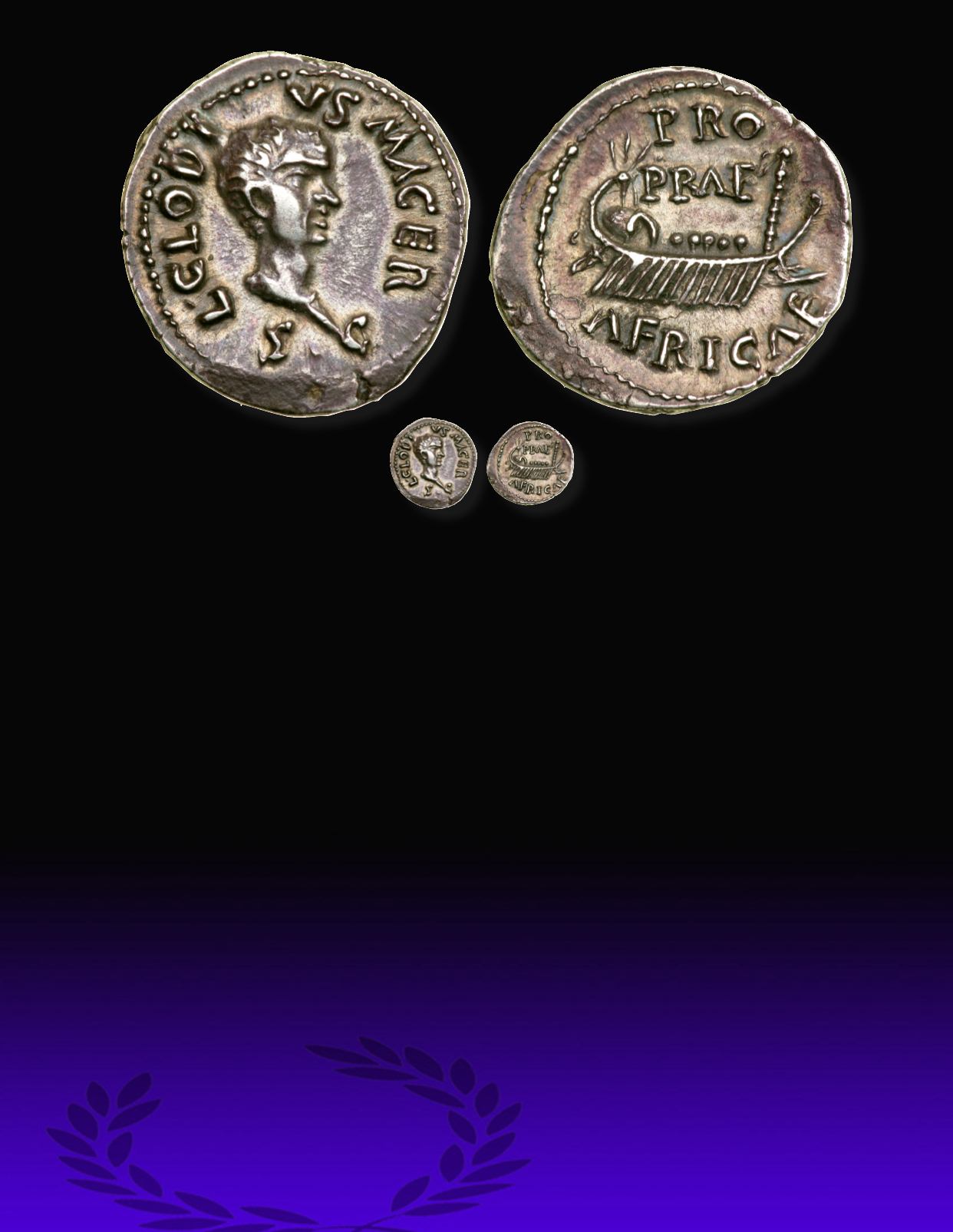
124
3124
Clodius Macer. Silver Denarius (3.62 g), Governor of Africa, AD
68.
Carthage. L CLODI-VS MACER, S C below bust, bare head
of Clodius Macer right.
Reverse:
PRO/PRAE in two lines above,
AFRICAE below, war galley with aplustre and five oarsmen sailing
right. RIC 37; K. V. Hewitt,
NC
1983, 55 (dies 31/37) = L. Milden-
berg,
Vestigia Leonis
p. 362, pl. LI, 1 (this coin); A. Gara,
RIN
1970,
p. 67, 7, and pl. 1, 11/12; BMC 1; RSC 13. An excellent portrait
unusually well-centered, complete and of excellent metal. Attrac-
tive old cabinet toning further adds to its appeal.
Exceedingly rare
and probably the finest specimen known
.
Superb Extremely Fine.
L. Clodius Macer was the propraetorian legate of the Legio III
Augusta based in Numidia during the latter part of Nero’s reign.
Historically, he was thought to have rebelled against Nero in the
name of the Senate of Rome, but recent study into the language
employed by Tacitus in his history of the period throws a shadow
over this interpretation. It seems instead that perhaps Macer was
first a loyal partisan of Nero, and only when overtaken by the
events of Nero’s suicide did he find himself in opposition to Gal-
ba. In this view, Nero sent his influential mistress, Calvia Crispinilla,
to Africa to assure Macer’s loyalty to the throne after Galba had
publicly declared his support for Vindex’s uprising, and that it was
only after Galba came to power that Macer began to act in a
more arbitrary manner, using his naval forces in an attempted in-
vestment of Sicily to blockade Rome and cut off her grain supply
(see G. Morgan, “Clodius Macer and Calvia Crispinilla,” Historia:
Zeitschrift für AlteGeschichte 49, 4 [4thQuarter, 2000]: pp. 467-87).
Supporting this interpretation of events is the evidence from
Macer’s coinage. While it has often been suggested that Macer
was attempting to either reestablish the Roman Republic, or al-
ternately that he aspired to the throne himself, these arguments
do not hold up upon closer scrutiny. The first argument is based
on the fact that Macer was even striking precious metal coinage,
a purely imperial prerogative for the past century, and that for
designs he chose types prevalent during the imperatorial period.
Countering this is that both Galba and perhaps also Vindex pre-
empted him, striking anonymous issues themselves, and Macer’s
choice of types merely provided the consumer the comfort of
the conventional since earlier denarii of course still circulated
widely in Africa in the AD 60s. The second argument is based
in part on the fact that Macer put his name on his coins, and
that on one issue - probably his last - he even included his own
portrait. Although it is true that Macer’s denarii are not anony-
mous, with notable modesty they all clearly give his title as mere
procurator of a legion in Africa. There is also ample precedent
for using his own portrait, which notably is not laureate. Addi-
tionally, although it seems highly improbable that the Senate
ever empowered Macer to strike coinage, all of his coins without
exception claim to be operating S C. This and his modest title
are compelling enough reasons to see that Macer had no de-
lusional grandeur of aspiring to the purple, and should instead
be seen as putting the best face on his own actions while at
the same time reassuring the people that his money was sound.
After Macer’s capture and execution by order of Galba, it would
seem that his coins were immediately recalled and melted,
the bullion of which was used for a short time at the Carthag-
inian mint to strike coins all with a comparably provincial style
for Galba. Hewitt records 77 known dies for Macer’s coinage
and extrapolates that there may have been more than 180
in total, so it was apparently substantial. However, very speci-
mens survive today - fewer than 85 coins of all types, with at
most just twenty being portrait denarii - making this coin one
of the rarest in the entire history of Roman Imperial coinage.
Estimated Value............................................................. $50,000-UP
Ex Barry Feirstein Collection (NAC 39, 16 May 2007), 107; James
Fox Collection (CNG/NAC 40, 4 December 1996), 1402; Highly Im-
portant Greek and Roman Coins. The Nelson Bunker Hunt Collec-
tion, pt. I (Sotheby’s, 19 June 1990), 126; Sternberg III (29-30 Novem-
ber 1974), 47; Tunis Hoard.


